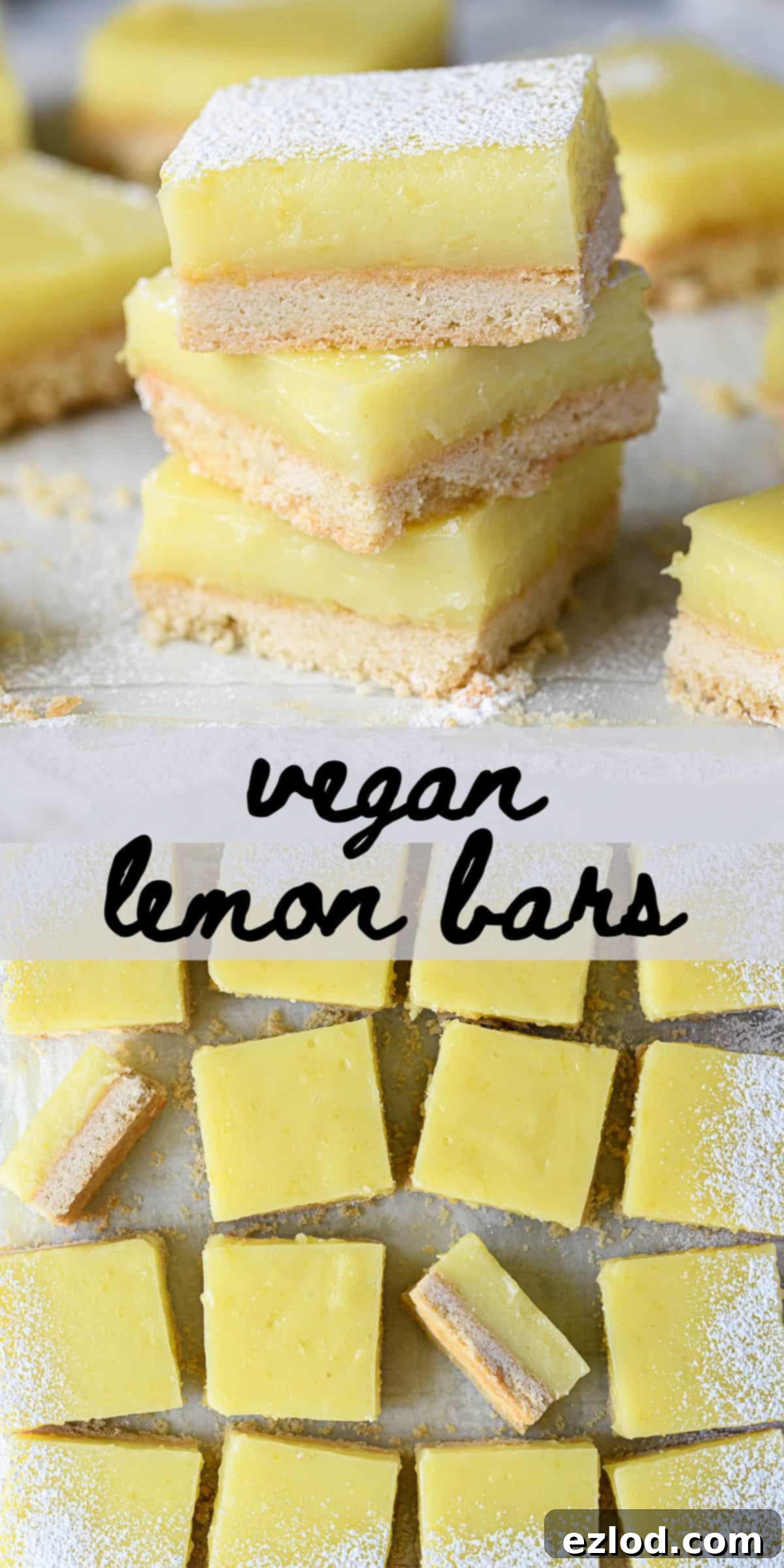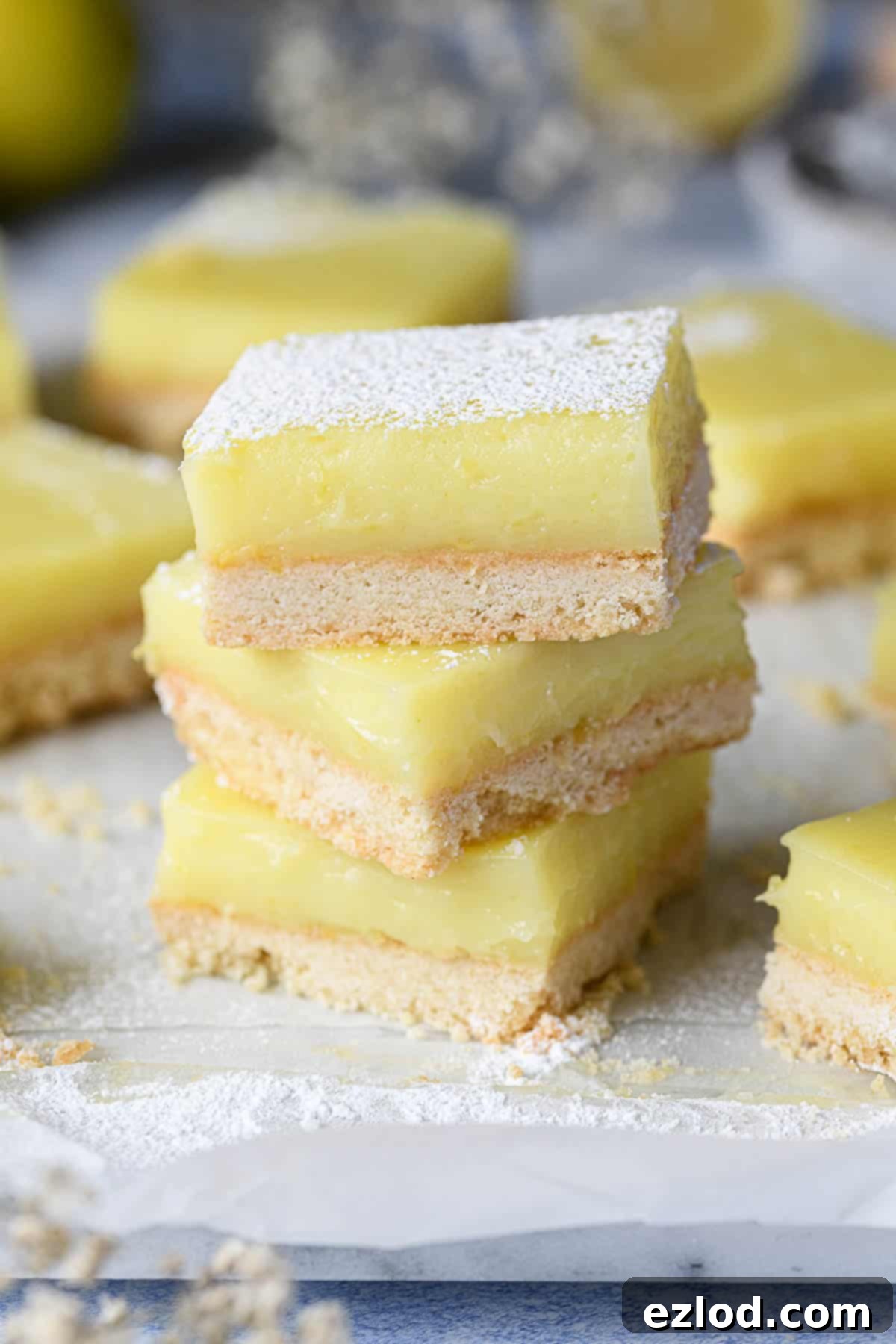The Ultimate Guide to Easy Vegan Lemon Bars: Tangy, Creamy & Irresistibly Delicious
Prepare to be enchanted by these utterly irresistible vegan lemon bars – a truly simple yet spectacular dessert that effortlessly combines a crisp, buttery shortbread base with a generous layer of thick, creamy, and wonderfully tangy lemon curd. Perfect for any occasion, these plant-based treats are not just easy to make from everyday ingredients, but they’re also incredibly moreish, ensuring they’ll disappear quickly from any platter!
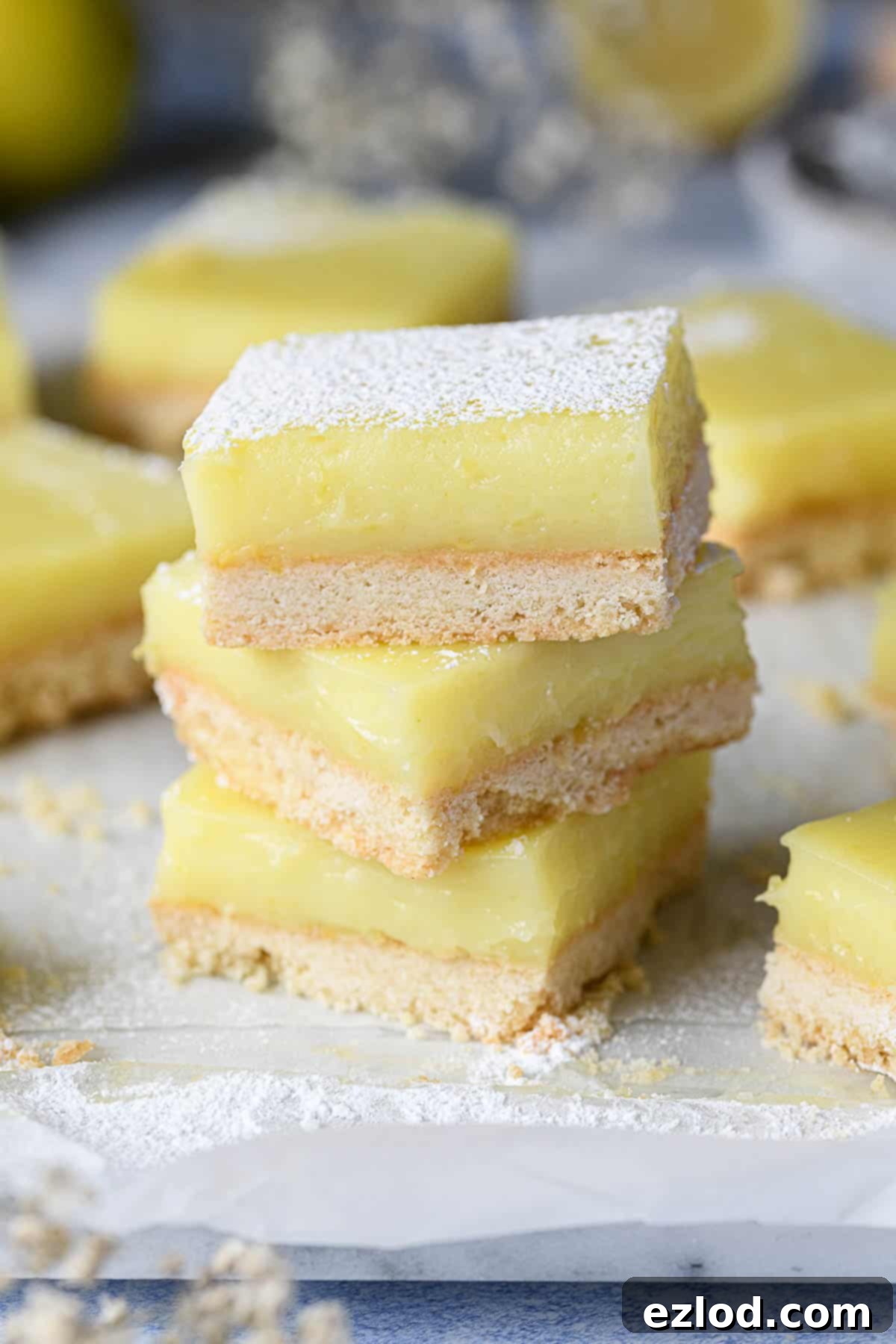
There’s something uniquely satisfying about a perfectly crafted lemon bar. That delightful contrast between a tender, crumbly base and a bright, zesty topping is a culinary masterpiece. Our vegan lemon bar recipe takes this classic dessert and reimagines it for plant-based diets, delivering all the flavor and texture you love without any dairy or eggs. You’ll find these bars dangerously addictive, with their vibrant lemon flavor cutting through the richness of the buttery shortbread, creating a harmonious balance that will leave you reaching for another slice.
This recipe is a labor of love, drawing inspiration from two of my most popular creations: my renowned vegan lemon curd and my beloved vegan shortbread fingers. For the filling, I’ve fine-tuned the lemon curd recipe to achieve a creamier texture that sets beautifully, allowing for clean, perfect slices. The shortbread base, crisp, buttery, and melt-in-your-mouth, provides the ideal foundation, a divine counterpoint to the sharp, sweet lemon.
One of the key distinctions of this recipe, setting it apart from many traditional lemon bar methods, lies in its construction. Often, recipes instruct you to bake the lemon topping directly on top of the shortbread. However, I’ve found this approach can lead to a less than ideal outcome – a soggy shortbread base that loses its delightful crispness. To avoid this common pitfall, my method involves cooking the luscious lemon curd separately in a pan until it reaches a thick, glossy consistency. Only then is it poured over the already baked and perfectly golden shortbread base. This ingenious technique ensures that the shortbread remains wonderfully crisp, creating a superior textural contrast between the buttery base and the silky, tangy lemon layer. The curd then sets beautifully as it cools, requiring no further baking. This attention to detail guarantees a truly exceptional homemade vegan lemon bar experience every time.
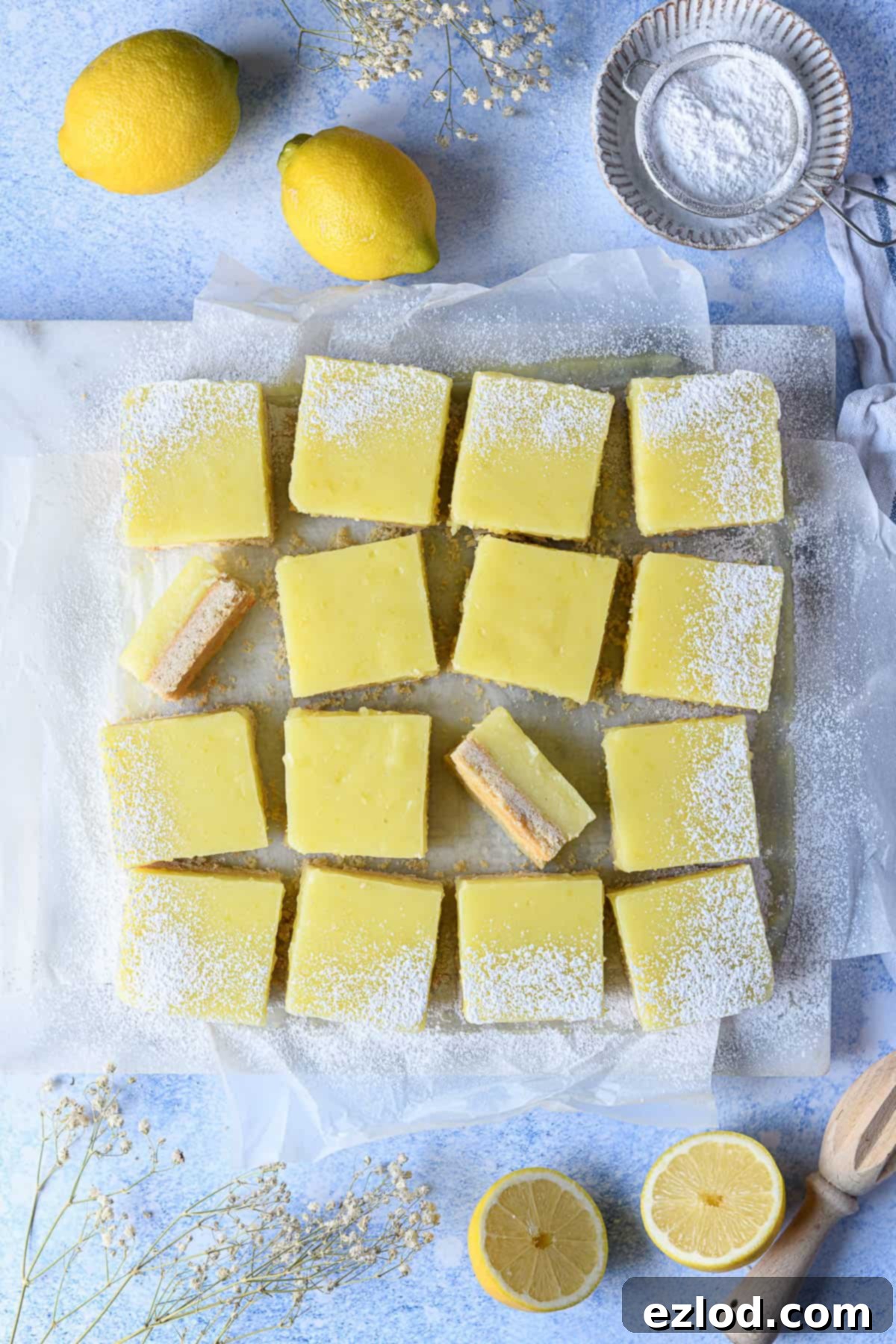
Essential Ingredients for Your Vegan Lemon Bars:
Crafting the perfect vegan lemon bar begins with selecting the right ingredients. Each component plays a vital role in achieving that perfect balance of crispness, creaminess, and zesty flavor. Here’s a detailed look at what you’ll need and why:
For the Buttery Shortbread Base:
- Vegan Block Butter: This is arguably the most crucial ingredient for your shortbread base. It is absolutely essential to use a high-quality vegan block butter or margarine, rather than the spreadable kind found in tubs. Block butters have a higher fat content and different emulsifiers, which are vital for achieving that classic crumbly, melt-in-your-mouth shortbread texture. Spreadable varieties tend to result in a chewier, less desirable texture. Since shortbread’s primary flavor comes from the butter, choose a brand you genuinely enjoy the taste of. Brands like Naturli Vegan Block, Flora Plant block, or Stork block are excellent choices that perform reliably in baking.
- Caster Sugar: Caster sugar, with its finer granules, blends more readily and evenly with the vegan butter, contributing to a smoother dough and a more delicate texture in the finished shortbread. While granulated sugar can be used in a pinch, caster sugar will yield superior results.
- Vanilla Extract: Traditionally, shortbread relies solely on the butter for its flavor. However, to compensate for the subtle differences in flavor between vegan butter and dairy butter, a touch of good quality vanilla extract adds a wonderful depth and warmth, enhancing the overall taste without overpowering the natural richness of the shortbread.
- Plain Flour (All-Purpose Flour): Standard plain or all-purpose flour is ideal for this recipe. Its moderate protein content ensures a tender yet firm shortbread. Substituting with other types of flour, especially those with higher protein, may alter the texture significantly, so it’s best to stick to plain flour for consistent results.
- Cornflour (Cornstarch): This is a secret weapon for truly exquisite shortbread. While many basic shortbread recipes use only flour, butter, and sugar, incorporating a small amount of cornflour (cornstarch) results in an incredibly tender, almost melt-in-the-mouth texture. It reduces gluten formation, making the shortbread exceptionally delicate. If you don’t have cornflour, you can substitute it with an equal weight of plain (all-purpose) flour, but the texture might be slightly less tender.
- Pinch of Salt: A small amount of salt is essential to balance the sweetness and enhance the overall flavor of the shortbread, bringing out the richness of the butter and vanilla.
For the Creamy Lemon Curd Filling:
- Cornflour (Cornstarch): In traditional lemon curd, egg yolks provide the thickening and setting power. In this vegan version, cornflour (cornstarch) takes on this crucial role, ensuring the curd sets firmly enough to be sliced while maintaining a wonderfully smooth and creamy consistency. It’s important not to substitute cornflour with other starches or flours, as they may not provide the same optimal texture.
- Fresh Lemons: The star of the show! For the most vibrant, authentic lemon flavor, fresh lemons are non-negotiable. You’ll use both the finely grated zest (where most of the essential oils and intense flavor reside) and the freshly squeezed juice. Plan on needing about 7 medium to large lemons to yield the required amount of juice and zest.
- Water: A small amount of water is included to temper the intensity of the lemon juice, ensuring the bars are delightfully tangy but not overwhelmingly sour. If you adore an extra potent lemon kick, feel free to substitute some or all of the water with additional lemon juice.
- Coconut Cream: This ingredient is key to achieving the luxurious, creamy texture and rich mouthfeel of the vegan lemon curd. I typically use full-fat coconut cream from a carton (like the Blue Dragon brand). Alternatively, you can chill a can of full-fat coconut milk overnight and scoop out the thick, solid white cream from the top. While I’ve primarily tested this recipe with coconut cream, plant-based double creams (such as Elmlea Plant Double Cream) or homemade cashew cream (thinned to a double cream consistency) could potentially work, but results may vary.
- Caster or Granulated Sugar: Either type of sugar works well here, providing the necessary sweetness to balance the tartness of the lemons. Avoid using liquid sweeteners, as they can alter the consistency and setting properties of the curd.
- Vegan Block Butter: Similar to the shortbread, a good quality vegan block butter is added to the curd at the end. This enriches the flavor, contributes to its silky texture, and helps it set properly as it cools, giving it that characteristic lusciousness.
- Turmeric (Optional): For an added visual appeal, a tiny pinch of turmeric can be included. This naturally enhances the yellow color of the lemon curd, mimicking the hue typically provided by egg yolks. Be very careful not to add too much, as you don’t want to detect its flavor; a mere pinch is sufficient, and the color will deepen as the curd cooks.
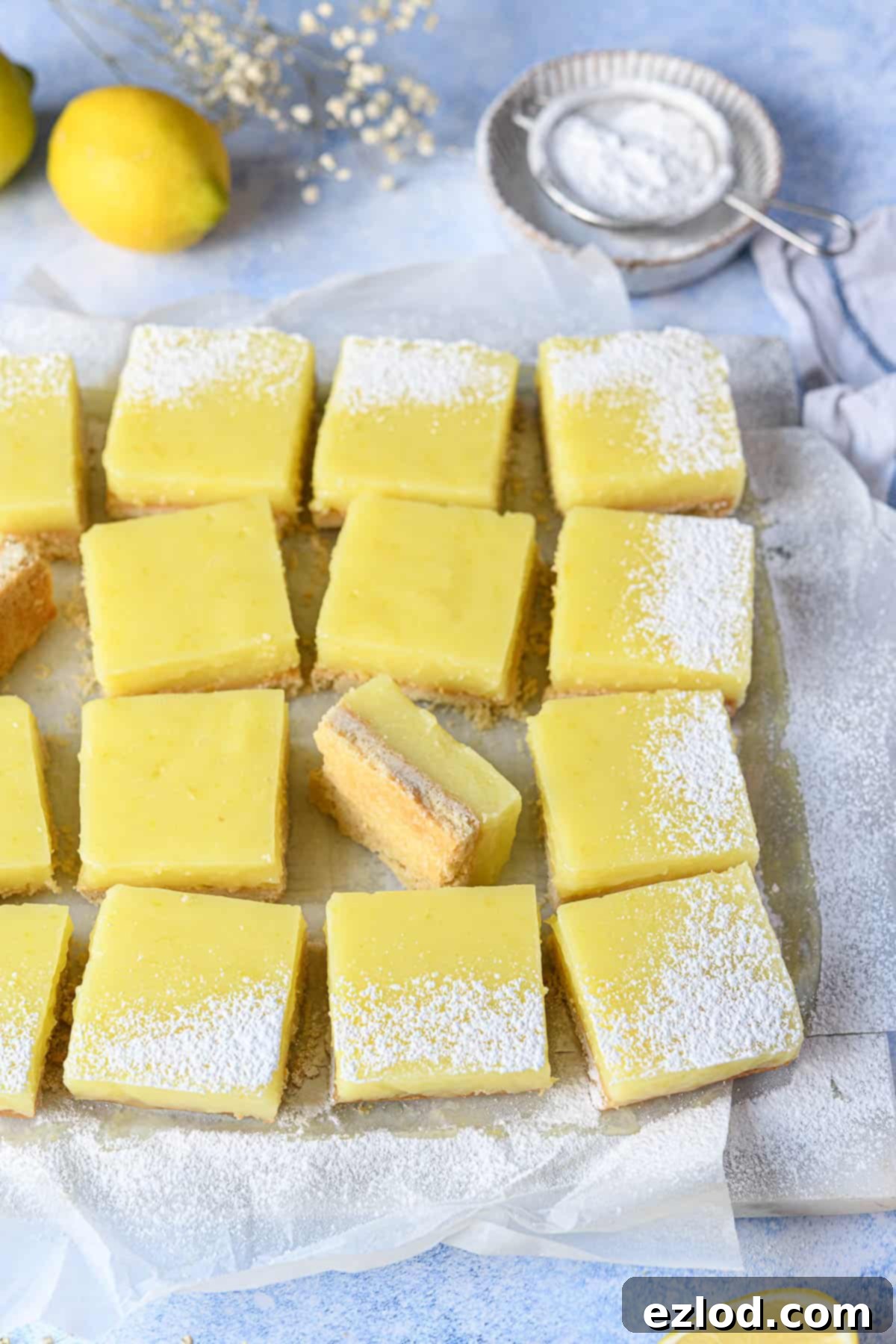
How To Make These Incredible Vegan Lemon Bars:
(For precise measurements and detailed step-by-step instructions, please refer to the comprehensive recipe card located at the very bottom of this page.)
Embarking on the journey to create these delightful vegan lemon bars is a straightforward and rewarding process. Follow these steps for a perfect outcome:
Step-by-Step Shortbread Base:
- Prepare Your Pan: Begin by preheating your oven to 180°C/160°C fan/350°F/gas mark 4. Lightly grease a 23 cm / 9 inch square cake tin. Line it with baking parchment, ensuring that you leave a generous overhang on two opposite sides. This “sling” will make it incredibly easy to lift the baked shortbread and subsequently the set lemon bars out of the tin without any fuss.
- Cream the Butter and Sugar: In a large mixing bowl, combine the slightly softened vegan block butter and the caster sugar. Using an electric mixer, beat them together until the mixture is visibly lightened in color and takes on a fluffy, aerated texture. This creaming process incorporates air, which is crucial for a tender shortbread. Next, whisk in the vanilla extract and a good pinch of salt, ensuring they are evenly distributed.
- Combine Dry Ingredients: In a separate bowl, sift together the plain flour and cornflour (cornstarch). Sifting helps to remove any lumps and ensures the dry ingredients are well combined and evenly dispersed.
- Form the Dough: Gradually add the sifted flour mixture to the creamed butter and sugar. Using a spatula, gently stir and fold the ingredients until they just come together to form a cohesive dough. At first, it might seem like there’s too much flour and the mixture is crumbly, but with continued gentle stirring, it will eventually combine into a soft dough. Be careful not to overmix, as excessive working of the dough can develop the gluten in the flour, leading to a tough, chewy shortbread rather than the desired crisp, crumbly texture.
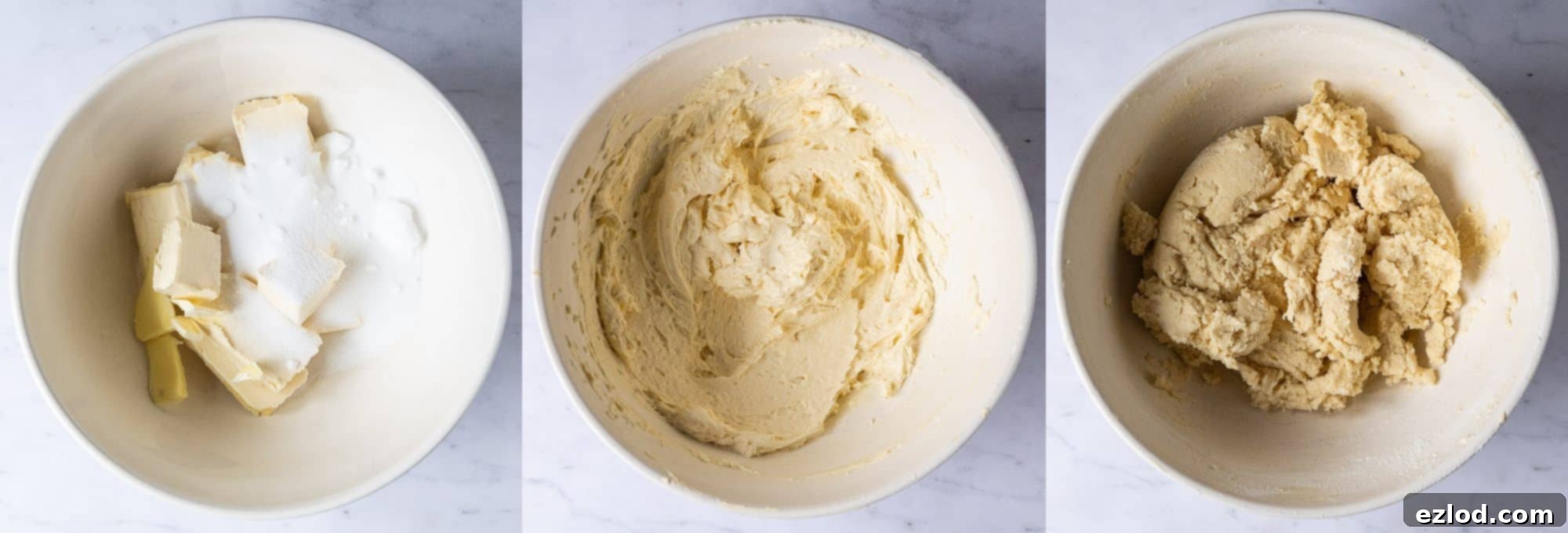
- Press into the Tin: Transfer the shortbread dough into your prepared cake tin. Using your hands or the back of a spoon, press the dough down as firmly and as evenly as possible across the entire base of the tin. Aim for a uniform thickness to ensure even baking.
- Bake the Shortbread: Place the tin in the preheated oven and bake for approximately 30 minutes, or until the shortbread turns a beautiful golden brown color around the edges and feels firm to the touch. If you notice it puffing up slightly during baking, gently press it back down with the back of a spoon or a flat spatula as soon as it comes out of the oven. This helps to maintain a flat surface for your lemon curd.
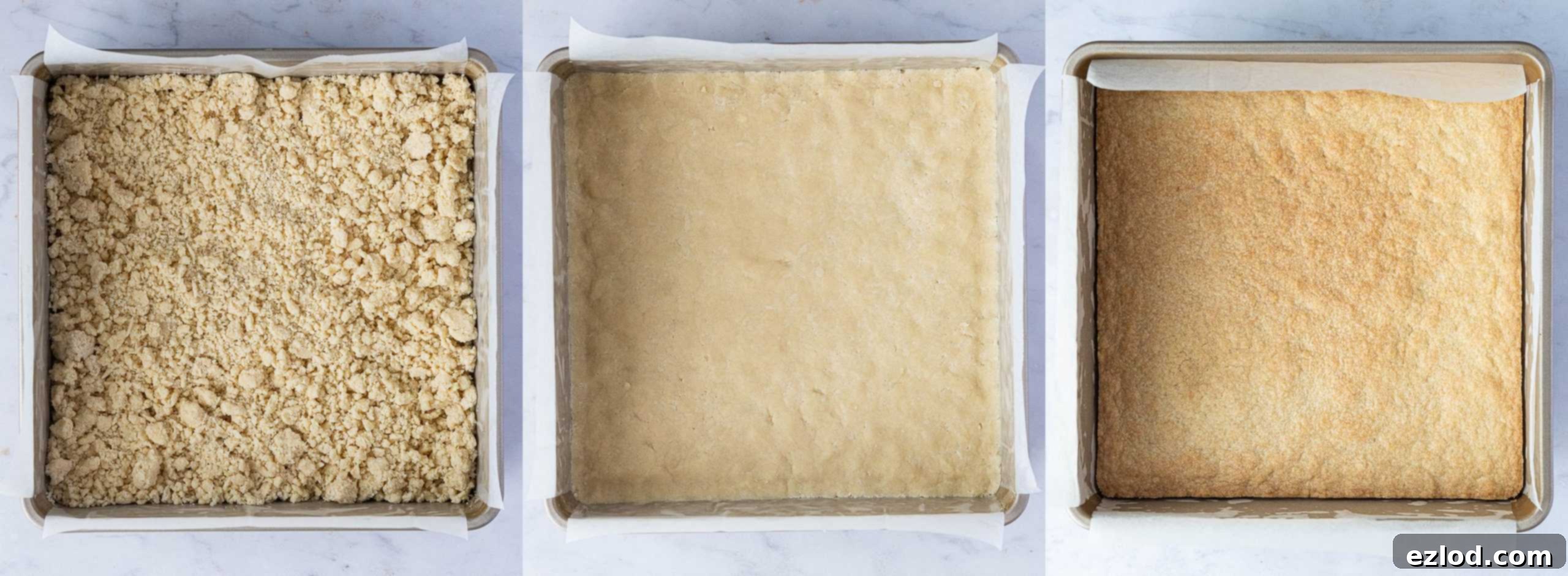
Step-by-Step Creamy Lemon Curd:
While your shortbread is baking, you can efficiently prepare the vibrant lemon curd filling:
- Create a Cornflour Slurry: In a non-reactive saucepan (stainless steel is ideal – avoid aluminum or copper, which can react with the lemon acid and turn your curd green), place the cornflour (cornstarch). Gradually whisk in the cold water until you have a completely smooth, lump-free paste. This slurry prevents the cornflour from clumping when heated.
- Combine Wet Ingredients: Into the cornflour slurry, whisk in the fresh lemon juice, lemon zest, caster or granulated sugar, coconut cream, a pinch of salt to enhance the flavors, and the optional pinch of turmeric for color. Stir until all ingredients are well combined.
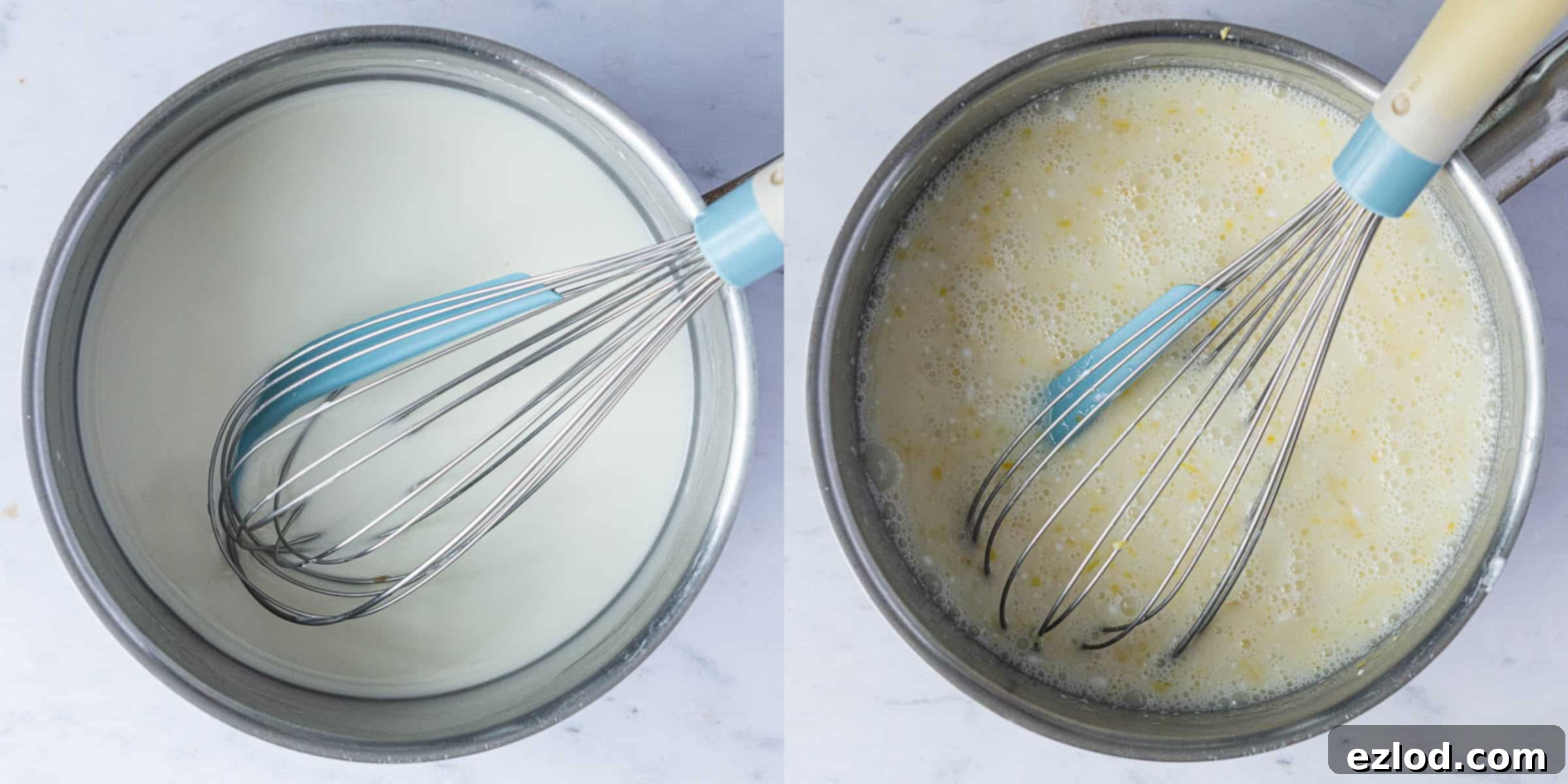
- Thicken the Curd: Once the shortbread is removed from the oven, place your saucepan with the lemon curd mixture over a medium heat. Stir constantly with a whisk or spatula. It’s crucial to stir continuously to prevent the bottom from scorching and to ensure even thickening. The mixture will gradually thicken and come to a boil, becoming considerably dense and glossy, similar to a thick pudding. This process usually takes several minutes. Don’t rush it; ensure it boils and thickens thoroughly for a properly set curd.
- Add Vegan Butter: Immediately remove the thickened lemon curd from the heat. Add the remaining vegan block butter to the hot curd and stir vigorously until it has completely dissolved and is fully incorporated, making the curd incredibly smooth and rich.
- Assemble the Bars: Without delay, pour the freshly cooked, still warm lemon curd directly over the baked shortbread base in the cake tin. Use a spatula to gently spread the curd into an even layer, reaching all the way to the edges.
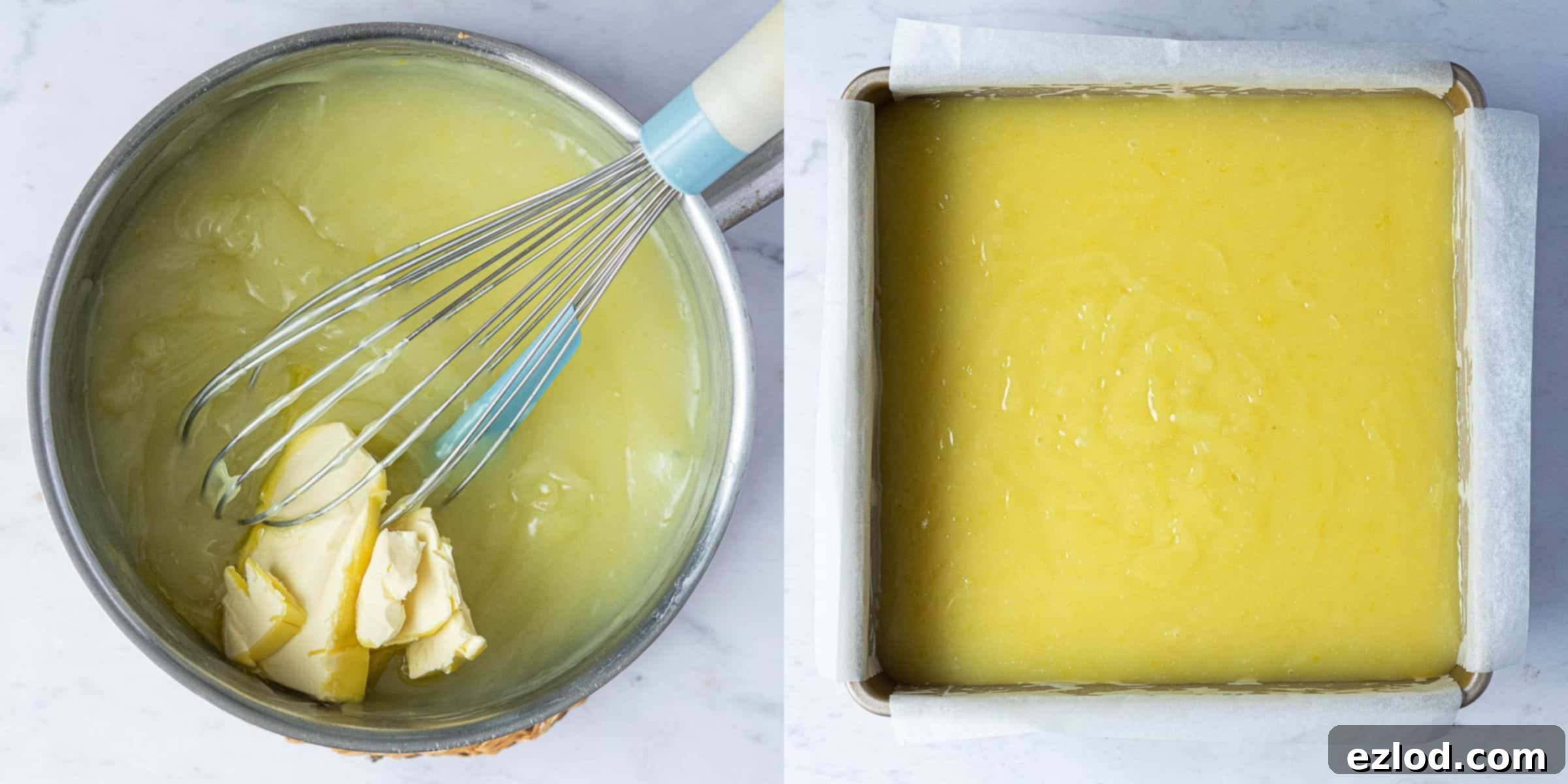
- Cool and Chill: Allow the assembled lemon bars to cool at room temperature for about 30 minutes. This initial cooling helps the curd begin to set. After this, transfer the tin to the refrigerator and chill for at least 2 hours. Chilling is essential for the curd to firm up completely, making it easy to slice into neat, beautiful bars.
- Slice and Serve: Once thoroughly chilled, use the parchment paper overhang to carefully lift the entire slab of lemon bars out of the tin. Place it on a cutting board. For the cleanest cuts, use a very sharp knife, wiping it clean between each slice, especially after the first few cuts. Dust with a little powdered sugar just before serving, if desired.
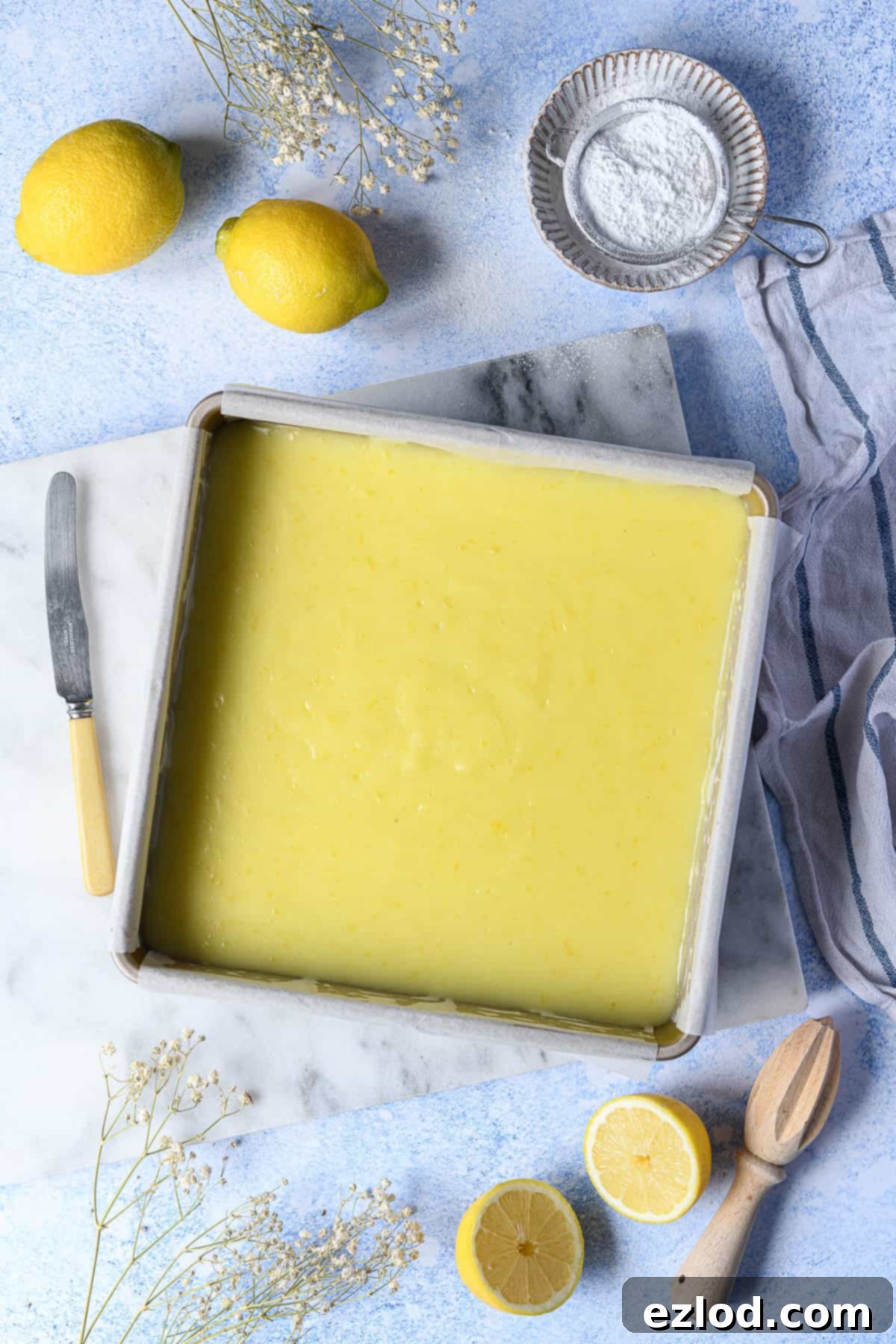
Top Tips for Perfect Vegan Lemon Bars:
Achieving baking perfection often comes down to a few key details. Here are some invaluable tips to ensure your vegan lemon bars turn out absolutely flawless every single time:
- Embrace Metric Measurements: As with all my baking recipes, I wholeheartedly recommend using metric measurements with a digital kitchen scale over volumetric cup conversions. Baking is a precise science, and cups, especially for dry ingredients, can be wildly inaccurate due to variations in how ingredients are packed. Using a scale guarantees consistency, better results, and often a less messy process!
- Versatile Lemon Curd: The fantastic lemon curd filling in this recipe isn’t just for bars! It’s incredibly versatile and can also be used as a delicious filling for a vegan lemon meringue pie, tarts, cakes, or simply enjoyed straight from the spoon.
- Fresh Lemons Make a Difference: For the most vibrant, bright, and authentic lemon flavor, always opt for fresh lemons. Bottled lemon juice, while convenient, simply cannot replicate the complex and fresh taste that comes from freshly squeezed juice and, crucially, fresh zest. The difference in flavor is truly remarkable.
- Butter Temperature for Shortbread: The vegan block butter for your shortbread should be slightly softened, but not warm or melted. It should be just soft enough that if you press it with your finger, it leaves a slight indentation. If it’s too soft, your shortbread might be greasy; too hard, and it won’t cream properly. If you’re using an electric mixer, you can even start with butter straight from the fridge as the mixer will warm it up slightly.
- Avoid Overworking the Dough: When combining the flour mixture into the creamed butter and sugar for the shortbread, mix only until the ingredients are just combined and a dough forms. Overworking the dough develops the gluten in the flour, which leads to a tough, chewy shortbread texture rather than the desired light and crumbly one. Resist the urge to knead it!
- Choose a Non-Reactive Pan for the Curd: When making the lemon curd, it is crucial to use a non-reactive saucepan. Materials like stainless steel or enamel-coated cast iron are perfect. Avoid aluminum or copper pans, as the acidity in the lemon juice can react with these metals, potentially causing your beautifully yellow curd to turn an unappetizing greenish color and impart a metallic taste.
- Chill Thoroughly: Patience is a virtue, especially with lemon bars! Ensure the bars are fully chilled in the refrigerator for at least two hours (or even overnight) before attempting to slice them. A well-chilled curd will be firm and allow for clean, precise cuts, giving you perfectly formed bars.
Storing Your Delicious Vegan Lemon Bars:
These exquisite vegan lemon bars are not only a joy to make but also incredibly convenient to store, making them an ideal make-ahead dessert! Once cooled and sliced, they should be stored in an airtight container in the refrigerator. Properly stored, they will maintain their fresh taste and perfect texture for approximately one week. This makes them fantastic for meal prep, entertaining, or simply enjoying throughout the week as a delightful treat.
Can I Freeze Vegan Lemon Bars?
Absolutely! Vegan lemon bars freeze exceptionally well, which is great news if you want to prepare them in advance or save some for later. Once the bars are completely chilled and firm, slice them into individual squares. Arrange these squares in a single layer on a baking sheet lined with parchment paper, and place them in the freezer until they are completely solid. Once frozen solid, transfer the bars to an airtight freezer-safe container or a heavy-duty freezer bag, separating layers with parchment paper to prevent sticking. They can be frozen for up to three months. To serve, simply transfer the desired number of bars to the refrigerator and allow them to defrost slowly overnight or for several hours until soft enough to enjoy.
Can I Make Vegan Lemon Bars Gluten-Free?
While I haven’t personally tested a gluten-free version of these specific vegan lemon bars, I believe they should work well with some adjustments. For the shortbread base, I would recommend using a good quality gluten-free all-purpose flour blend. If your chosen blend does not already contain xanthan gum, add about ½ teaspoon to the dry ingredients, as this helps with binding and mimics the elasticity that gluten provides. The lemon curd filling itself is naturally gluten-free, so no modifications are needed there. Always ensure all your other ingredients (like vegan butter, sugar, etc.) are certified gluten-free if you have severe dietary restrictions.
More Irresistible Vegan Lemon Desserts:
If you’ve fallen in love with the bright, zesty flavor of these lemon bars, you’ll be thrilled to discover more of my favorite plant-based lemon creations:
- Decadent Vegan Lemon Tart
- The Ultimate Vegan Lemon Drizzle Cake
- Creamy Vegan Lemon Blueberry Cheesecake
- Zesty Lemon Blueberry Polenta Cake
- Sweet Vegan Lemon Blueberry Rolls
- Moist Vegan Lemon Pound Cake
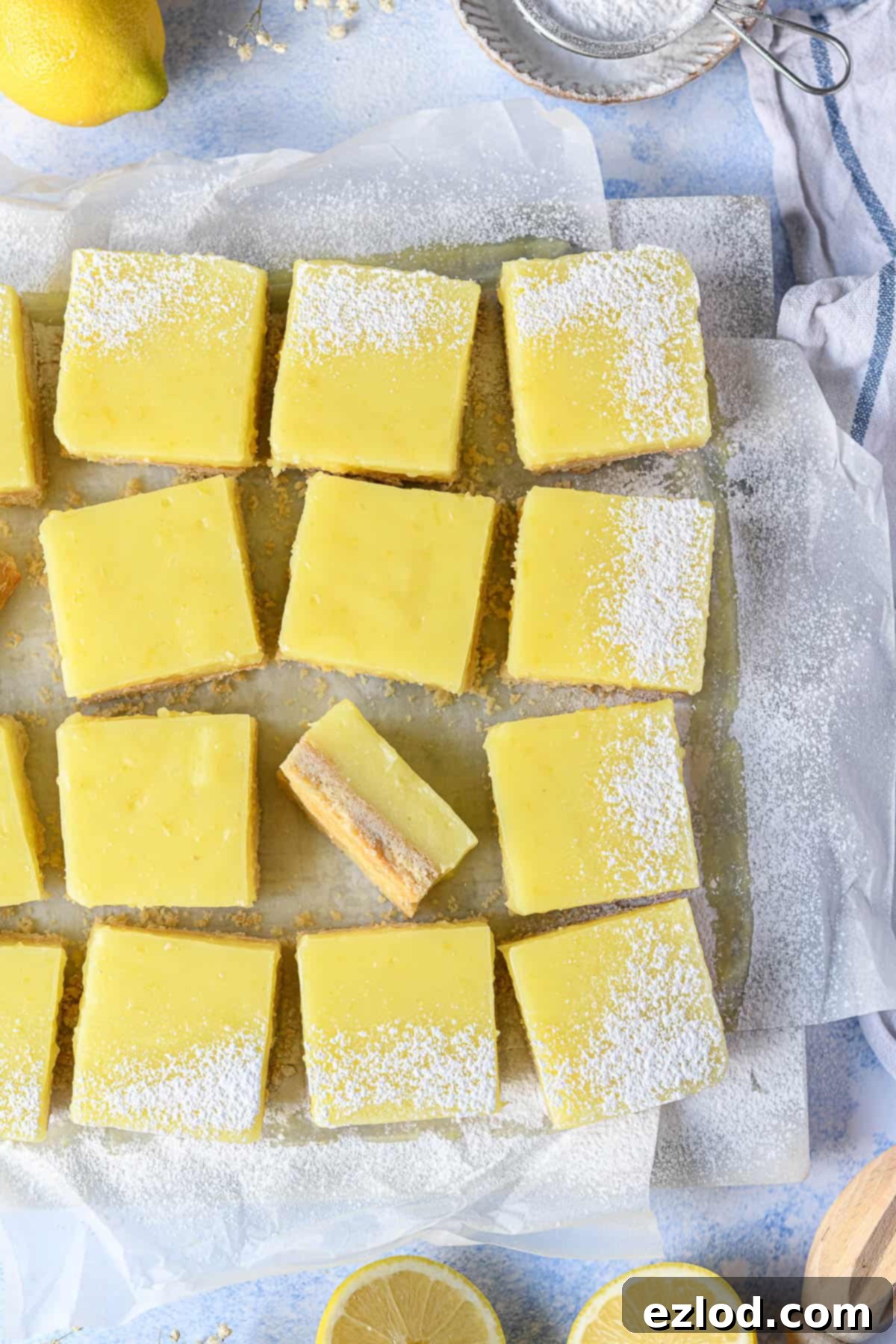
If you’ve tried this delightful recipe for vegan lemon bars, I would absolutely love to hear how it turned out for you! Please take a moment to rate it, leave a comment below with your feedback, or share your beautiful creations on Instagram by tagging @domestic_gothess and using the hashtag #domesticgothess. Your reviews and photos truly make my day!
All images and content on Domestic Gothess are copyright protected. If you wish to share this recipe, please do so by utilizing the provided share buttons. Kindly refrain from screenshotting or posting the recipe or its content in full; instead, include a direct link back to this post for the complete recipe. Thank you for your understanding and support!

Print
Vegan Lemon Bars
Ingredients
For the Shortbread Base:
- 175 g (¾ cup) vegan block butter (NOT spreadable kind, slightly softened. E.g., Naturli, Flora Plant, Stork)
- 80 g (¼ cup + 2 Tbsp) caster or granulated sugar
- 1 tsp vanilla extract
- pinch of salt
- 225 g (1 + ¾ cups + 2 Tbsp) plain (all-purpose) flour
- 25 g (2 ½ Tbsp) cornflour (cornstarch)
For the Creamy Lemon Curd:
- 65 g (6 ½ Tbsp) cornflour (cornstarch) (*do not substitute for other starches/flours)
- 120 ml (½ cup) cold water
- finely grated zest of 3 lemons
- 250 ml (1 cup) fresh lemon juice (approx. 7 medium/large lemons)
- 275 g (1 + ⅓ cups + 2 tsp) caster or granulated sugar
- 170 g (⅔ cup + 2 tsp) full-fat coconut cream (from carton or solid part of chilled can)
- a pinch of salt
- a pinch of turmeric (optional, for color)
- 70 g (¼ cup + 2 tsp) vegan block butter (e.g., Naturli Vegan Block)
Instructions
-
Preheat oven to 180°C/160°C fan/350°F/gas mark 4. Grease a 23cm / 9inch square cake tin and line with baking parchment, leaving an overhang to easily lift bars later.
-
Make the Shortbread: In a large bowl, whisk softened vegan butter and caster sugar with an electric mixer until light and fluffy. Whisk in vanilla extract and a pinch of salt.
-
Sift plain flour and cornflour (cornstarch) together, then add to the butter mixture. Stir with a spatula until a dough forms. Do not overmix.
-
Press the dough firmly and evenly into the prepared cake tin using your hands.
-
Bake for about 30 minutes until golden brown. If it puffs up, gently press it down.
-
Prepare the Lemon Curd: While shortbread bakes, place cornflour in a non-reactive saucepan. Gradually whisk in cold water to form a smooth paste.
-
Whisk in lemon juice, lemon zest, sugar, coconut cream, a pinch of salt, and the optional pinch of turmeric.
-
When shortbread is ready, place the curd pan over medium heat. Stir constantly until it boils and thickens considerably to a pudding-like consistency.
-
Remove from heat, add the remaining vegan butter, and stir until completely dissolved. Immediately pour the hot lemon curd over the baked (still warm) shortbread base.
-
Spread level and let cool at room temperature for 30 minutes, then refrigerate for at least 2 hours (or preferably longer) before slicing into bars with a sharp, clean knife.
Notes
- For best results in baking, always use metric measurements with a digital scale rather than inaccurate cup conversions.
- *Do not substitute cornflour (cornstarch) in the curd for other starches or flours; the desired texture will not be achieved.
- Ensure vegan block butter for shortbread is slightly softened but not warm for optimal creaming and texture.
- Avoid overworking the shortbread dough to prevent a chewy texture; mix just until combined.
- Use a non-reactive saucepan (like stainless steel) for the lemon curd to prevent discoloration and metallic taste.
- See the main blog post above for comprehensive tips, detailed photos, and extensive storage/freezing instructions.
